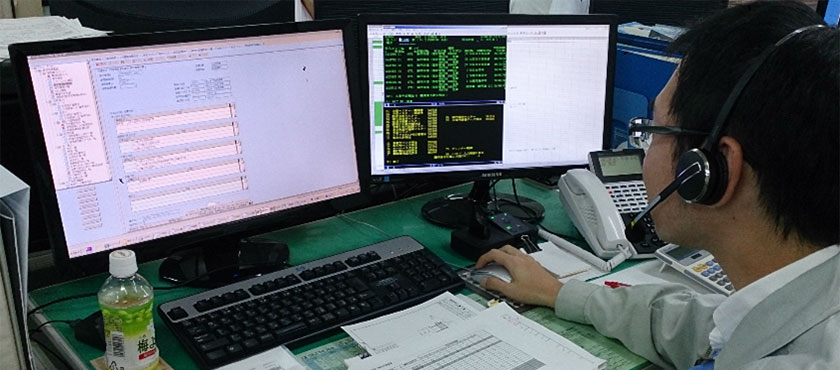IPAD SOLUTION FOR JCM REPAIR AND MAINTENANCE STAFF IMPROVES SERVICE AND EFFICIENCY
Editors Note: The case study below is based on an article published by www.imagazine.co.jp
If all that IBM i users get to see are 5250 screens, it is not surprising that the platform is perceived to be legacy. Management and CIO’s with limited IBM i knowledge are prone to give a willing ear to people who point and accuse: “Look how outdated and limited that old computer is, let’s replace it with something new!”
The IT team at Japan Cash Machine (JCM), with the help of LANSA partner Neoaxis, took a pro-active approach not waiting for those accusations to fester. Looking at the pain-points in the company, they determined that JCM’s maintenance and repair system was a prime candidate for improvement and transformation. JCM’s 150 repairmen now use iPads with integrated hand-writing, signature capture and camera features to create and submit their repair reports, and to look-up maintenance data. Call centre, admin and quality control staff have a productive rich client interface to real-time and integrated maintenance, billing and customer information.
The new solution, developed with LANSA and deployed on IBM i, has helped to improve the quality and speed of customer service and has drastically reduced the workload for JCM’s staff.
- The Challenge
- Evaluation of Technologies
- The Project and Solution
- The Benefits
- Conclusion
- Company and System Information
The Challenge
Japan Cash Machine, under the brand name JCM Global, is the world’s leading provider of money handling machines, such as bill validators that are used in casinos, ATMs, automatic ticketing machines, fare adjustment devices, vending machines and other kiosk terminals. JCM’s machines can handle most of the world’s currencies and denomination, and with sales and service centres in all major continents, JCM’s reach is truly global.
JCM has over 200 service centers in Japan. To support its operations in Japan, JCM uses in-house developed applications for Manufacturing, Sales, Distribution and Accounting, which run on the IBM i operating system. These systems are RPG-based and have evolved since 1995.
JCM’s maintenance division in Japan consists of 150 staff and contractors who visit on average around 100 customer sites each day. The high volume is not surprising, considering that Japan has the world’s highest number of vending machines per capita (5.8 million vending machines, one for every 23 people). In addition Japan has a large number of pachinko/slot machines in gaming parlors, plus of course there the regular ATMs, ticketing machines, and so on.
Before the implementation of JCM’s new Maintenance &Repair system, details of the customers’ products, product locations and their service/repair history were kept in a Microsoft Access database. When call center staff received a service or repair request, they would search the MS Access database to confirm the customer, location and machine details.
After the call they would create a service/repair request and fax it to the JCM support office or agency located nearest to the customer. The serviceman in charge would then visit the customer site with the request form. When the service work was completed, a repair report was filled out and signed by the customer, which was then sent by post to JCM’s head office. Upon receipt of the repair report, head office staff would enter the details into the MS Access maintenance history system, as well as into an IBM i-based billing system.
This traditional process was inefficient. Neither the RPG-based systems, nor the MS Access system allowed for sharing of information between staff in the office and technical staff in the field. In addition to double data entry, and the inconsistencies and type errors that came with it, another issue was the time lag caused by having to wait for the mailed reports. The business implications of these issues were all negative:
- Lack of real-time verification caused delayed and inaccurate responses to the customer.
- Inability to share information caused mistakes and delays in the delivery of replacement parts.
- Waiting for mailed reports stagnated the billing process and caused all related info to be out of date.
- In order to still meet its SLAs (Service Level Agreements) both field staff and office staff regularly had to work overtime.
Neither the RPG-based systems, nor the MS Access system allowed for sharing of information between staff in the office and technical staff in the field.
Evaluation of Technologies
Part of the plan to improve the business process was to provide field staff with mobile access to maintenance and inventory data. But JCM first had to create a better and more integrated Maintenance & Repair solution.
Mr. Kenta Shintani, heading JCM’s Information Systems Group, explained “We needed a solution that was truly integrated with our Customer, Inventory, Billing and Product information systems. Plus we wanted the information to be available across all divisions, with a productive Windows interface for office staff and a mobile web interface for field staff and contractors.”
“We have an IT team of five, of which only three have development skills. It was obvious that we could not do this project with RPG and 5250 screens, but we had no other development skills in our team. It was hard to determine which technology we should use, because there are so many technologies out there.”
“After some research we chose the Visual LANSA development tool, which our IBM partner Neoaxis had introduced to us. The 4GL syntax was easy to understand and reminded us of Visual Basic. LANSA showed a strong affinity with IBM i and it could easily integrate with our existing RPG and CL programs.”
“Another reason to choose LANSA was that we could use the same tools and skills for mobile and web development, as well as for rich client applications. Last, but not least, from LANSA’s case study examples it was clear that many other companies had successfully used the product for similar projects.”
With LANSA we could use the same tools and skills for mobile and web development, as well as for rich client applications.

The Project and Solution
Mr. Kenta Shintani explains, “The new maintenance management system was created by consolidating the maintenance history, sales and inventory systems into an integrated client/server solution with a rich Windows GUI. This system is now used by call center and administration staff. Simultaneously we developed a mobile web application for iPads, for use by maintenance staff and external contractors.”
JCM’s own three programmers developed the client-server system, which consists of about 70 Windows rich client screens. The application offers sophisticated search facilities on customers, machines, maintenance history and inventory of spare parts and allows staff to open multiple tabs simultaneously.
The mobile web application for field staff, consisting of 20 screens, was developed with the help of Neoaxis. Staff use it to look-up customer, machine, maintenance history and spare part details and to enter maintenance reports. The repair report on the iPad looks very similar in layout to the paper report, making the transition to digital reporting easy.
The solution is integrated with hand-writing software called “7notes” (from MetaMoji), allowing field staff to use a stylus pen to enter data. The hand-writing option is popular, especially with the older workers. The customer’s signature is also captured using the stylus pen and hand-writing software.
Field staff can take before-and-after repair photos and attach them to the report. The photos are Base64 encoded and uploaded to the IBM i server, where they are stored in the database together with sales and maintenance history data.
After one-month onsite LANSA training, requirement definition started in March 2013 and completed in around 5 months. The next six months were allocated for development, testing and iPad field-trials. After a three month trial period, the new Maintenance application went live in February 2014 to call center and admin staff, plus to 150 repair and maintenance workers in the field.
The next six months were allocated for development, testing and iPad field-trials.
The Benefits

The new system has helped to improve the quality and speed of customer service. Because field staff can check the maintenance history and availability of spare parts while on site, they can do their job better and faster. They can also respond quicker to customer enquiries.
Repair and maintenance data entered by field staff on their iPads is instantly available to accounting, call center and quality control departments.
Billing is triggered automatically upon receipt of the repair reports, optimizing JCM’s cash flow. Real-time availability of maintenance and billing data also allows call center staff to respond accurately to customers who ask about job progress or repair costs.
Maintenance information is now well structured and available to quality control for further analysis, assisting JCM to continuously improve its products and services.
Since maintenance reports are entered on site, re-keying and filing of paper-based reports is no longer required. This has drastically reduced the workload of call center and administration staff. The number of administration staff was reduced from seven to four. According to the company’s impact analysis, the number of man hours related to the handling of maintenance reports is now 10% of what it used to be. Over-time has decreased by 30%.
These efficiencies allow JCM to handle more jobs with their own staff, reduce the number contractors by three and be confident to meet their SLAs.
Field staff can check the maintenance history and availability of spare parts while on site, they can do their job better and faster. They can also respond quicker to customer enquiries.
Conclusion
Mr. Koji Imanishi, manager of Information System Group JCM, who led this project commented, “Key to the project’s success was the active involvement of the end users. We could easily show them the design of the system and they provided us with their feedback and additional suggestions. This helped us to better understand the business flow and visualize areas of improvement. Thanks to their feedback, we could offer a better solution. I was impressed that the graphical user interface made it so much easier to work closely with the end user.”
“Another success factor was the versatility of LANSA. We made maximum use of its re-usable component architecture with business rules and triggers and easy integration with third party technologies such as Microsoft Excel, PDF, email and workflow.”
“Previously users had a poor perception of the IBM i, because all that our users got to see were its 5250 screens. Now they can see the platform supports web, mobile and rich client applications. It can do anything if you use the right tools.”
Following the success of the Maintenance system project, JCM now plans to modernize and mobilize its Sales system by adding workflow management and automated email functionality, replacing the 5250 screens with Windows clients and by providing sales representatives with mobile access.
Previously users had a poor perception of the IBM i, because all that our users got to see were its 5250 screens. Now they can see the platform supports web, mobile and rich client applications. It can do anything if you use the right tools.
Company and System Information
- Neoaxis Co., Ltd, headquartered in Tokyo, Japan, provides IT solutions and services, with a focus on the IBM i platform. Neoaxis is a LANSA and IBM Business Partner.
For more information visit: www.neoaxis.co.jp - Japan Cash Machine, established in 1955, is the world’s leading transaction technologies supplier for the banking, retail, kiosk and gaming industries. JCM’s head office is in Osaka, Japan. Regional offices are in Australia, China, Germany, Hong Kong. Macau, United Kingdom, United States and Latin America.
For more information visit: www.jcm-hq.co.jp/english

